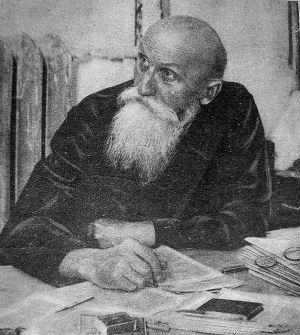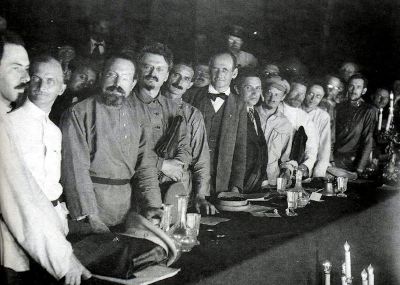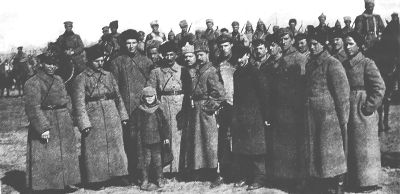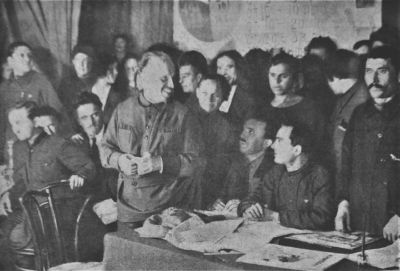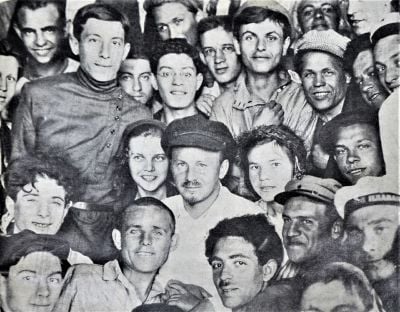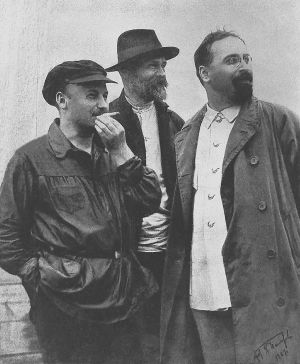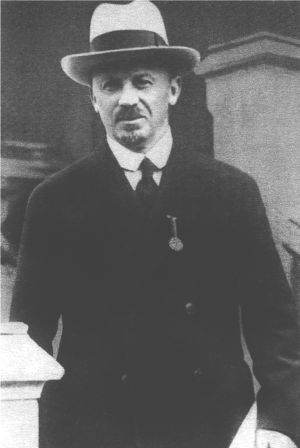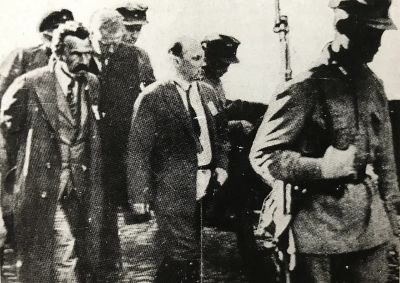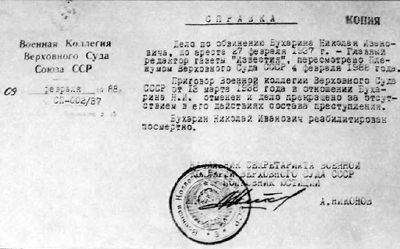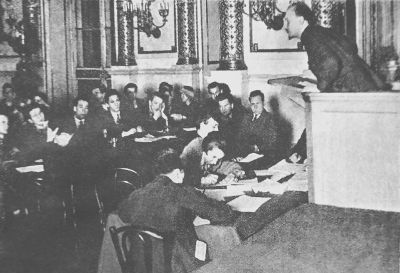Nikolai Bukharin
| Nikolai Bukharin | |
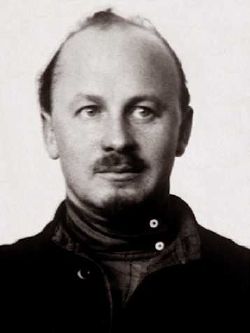 Bukharin in 1930 | |
| In office November 1926 – April 1929 | |
| Preceded by | Grigori Zinoviev |
|---|---|
| Succeeded by | Vyacheslav Molotov |
| In office November 1918 – April 1929 | |
| Preceded by | Joseph Stalin |
| Succeeded by | Mikhail Olminsky |
Full member of the 13th, 14th, 15th Politburo
| |
| In office June 2, 1924 – November 17, 1929 | |
Candidate member of the 8th, 9th, 10th, 11th, 12th Politburo
| |
| In office March 8, 1919 – June 2,1924 | |
| Born | October 9 1888 Moscow, Russian Empire |
| Died | March 15 1938 (aged 49) Moscow, Russian SFSR, Soviet Union |
| Political party | RSDLP (Bolsheviks) (1906–1918) Communist Party of the Soviet Union (1918–1937) |
| Spouse | Nadezhda Lukin Esfir' Gurvich Anna Larina |
| Children | 2 |
| Alma mater | Imperial Moscow University (1911) |
Nikolai Ivanovich Bukharin (Russian: Никола́й Ива́нович Буха́рин) (October 9 [O.S. September 27,] 1888 – March 15, 1938) was a Bolshevik revolutionary, Soviet politician, Marxist philosopher and economist and prolific author on revolutionary theory.
As a young man, he spent six years in exile working closely with fellow exiles Vladimir Lenin and Leon Trotsky. After the revolution of February 1917, he returned to Moscow, where his Bolshevik credentials earned him a high rank in the party. After the October Revolution he became editor of their newspaper, Pravda.
Within the Bolshevik Party, Bukharin was initially considered a left communist, but gradually moved to the right from 1921. His strong support for and defense of the New Economic Policy (NEP) eventually saw him lead the Right Opposition. By late 1924, this stance had positioned Bukharin favorably as Joseph Stalin's chief ally, with Bukharin soon elaborating Stalin's new theory and policy of Socialism in one country. Together, Bukharin, and Stalin ousted Trotsky, Grigory Zinoviev and Lev Kamenev from the party at the 15th Communist Party Congress in December 1927. From 1926 to 1929, Bukharin enjoyed great power as General Secretary of the Comintern's executive committee. However, Stalin's decision to proceed with collectivization drove the two men apart, and Bukharin was expelled from the Politburo in 1929.
When the Great Purges began in 1936, some of Bukharin's letters, conversations, and tapped phone-calls indicated disloyalty to Stalin. Arrested in February 1937, Bukharin was charged with conspiring to overthrow the Soviet state. After a show trial that alienated many Western communist sympathizers, he was executed in March 1938.
Before 1917
Nikolai Bukharin was born on September 27 (October 9, new style), 1888, in Moscow. He was the second son of two schoolteachers, Ivan Gavrilovich Bukharin and Liubov Ivanovna Bukharina.[1] According to Nikolai his father did not believe in God and often asked him to recite poetry for family friends as young as four years old.[2] His childhood is vividly recounted in his mostly autobiographic novel How It All Began.
Bukharin's political life began at the age of sixteen, with his lifelong friend Ilya Ehrenburg, when they participated in student activities at Moscow University related to the Russian Revolution of 1905. He joined the Russian Social Democratic Labor Party in 1906, becoming a member of the Bolshevik faction. With Grigori Sokolnikov, Bukharin convened the 1907 national youth conference in Moscow, which was later considered the founding of Komsomol.
By age twenty, he was a member of the Moscow Committee of the party. The committee was widely infiltrated by the Tsarist secret police, the Okhrana. As one of its leaders, Bukharin quickly became a person of interest to them. During this time, he became closely associated with Valerian Obolensky and Vladimir Smirnov. He also met his future first wife, Nadezhda Mikhailovna Lukina, his cousin and the sister of Nikolai Lukin, who was also a member of the party. They married in 1911, soon after returning from internal exile.
In 1911, after a brief imprisonment, Bukharin was exiled to Onega in Arkhangelsk, but he soon escaped to Hanover. He stayed in Germany for a year before visiting Kraków (now in Poland) in 1912 to meet Vladimir Lenin for the first time. During the exile, he continued his education and wrote several books that established him in his 20s as a major Bolshevik theorist. His work Imperialism and World Economy influenced Lenin, who freely borrowed from it[3] in his larger and better-known work, Imperialism, the Highest Stage of Capitalism. He and Lenin also often had hot disputes on theoretical issues, as well as on Bukharin's close relations with the European Left and his anti-statist tendencies. Bukharin developed an interest in the works of Austrian Marxists and non-Marxist economic theorists, such as Alexander Bogdanov, who deviated from Leninist positions. Also, while in Vienna in 1913, he helped the Georgian Bolshevik Joseph Stalin write an article, "Marxism and the National Question", at Lenin's request.
In October 1916, while based in New York City, Bukharin edited the newspaper Novy Mir (New World) with Leon Trotsky and Alexandra Kollontai. When Trotsky arrived in New York in January 1917, Bukharin was the first of the émigrés to greet him. (Trotsky's wife recalled, "with a bear hug and immediately began to tell them about a public library which stayed open late at night and which he proposed to show us at once," dragging the tired Trotskys across town "to admire his great discovery").[4]
From 1917 to 1923
At the news of the Russian Revolution of February 1917, exiled revolutionaries from around the world began to flock back to the homeland. Trotsky left New York on March 27, 1917, sailing for St. Petersburg.[5] Bukharin left New York in early April and returned to Russia by way of Japan (where he was temporarily detained by local police), arriving in Moscow in early May 1917. Politically, the Bolsheviks in Moscow were a minority in relation to the Mensheviks and Social Democrats. As more people began to be attracted to Lenin's promise to bring peace by withdrawing from the Great War, membership in the Bolshevik faction began to increase dramatically – from 24,000 members in February 1917 to 200,000 members in October 1917. Upon his return to Moscow, Bukharin resumed his seat on the Moscow City Committee and also became a member of the Moscow Regional Bureau of the party.[6]
The Bolsheviks themselves were divided into a right wing and a left wing. The right-wing of the Bolsheviks, including Aleksei Rykov Viktor Nogin, controlled the Moscow Committee, while the younger left-wing Bolsheviks, including Vladimir Smirnov, Valerian Osinsky, Georgii Lomov, Nikolay Yakovlev, Ivan Kizelshtein and Ivan Stukov, were members of the Moscow Regional Bureau. On October 10, 1917, Bukharin was elected to the Central Committee, along with two other Moscow Bolsheviks: Andrei Bubnov and Grigori Sokolnikov.[7] This strong representation on the Central Committee was a direct recognition of the Moscow Bureau's increased importance. Whereas the Bolsheviks had previously been a minority in Moscow behind the Mensheviks and the Socialist Revolutionaries, by September 1917 the Bolsheviks were in the majority in Moscow. Furthermore, the Moscow Regional Bureau was formally responsible for the party organizations in each of the thirteen central provinces around Moscow – which accounted for 37% of the whole population of Russia and 20% of the Bolshevik membership.
While no one dominated revolutionary politics in Moscow during the October Revolution as Trotsky did in St. Petersburg, Bukharin certainly was the most prominent leader in Moscow. During the October Revolution, Bukharin drafted, introduced, and defended the revolutionary decrees of the Moscow Soviet. Bukharin then represented the Moscow Soviet in their report to the revolutionary government in Petrograd. Following the October Revolution, Bukharin became the editor of the party's newspaper, Pravda.[8]
Bukharin believed passionately in the promise of world revolution. In the Russian turmoil near the end of World War I, when a negotiated peace with the Central Powers was looming, he demanded a continuance of the war, fully expecting to incite all the foreign proletarian classes to arms.Even as he was uncompromising toward Russia's battlefield enemies, he also rejected any fraternization with the capitalist Allied powers: he reportedly wept when he learned of official negotiations for assistance.[9]
Bukharin emerged as the leader of the Left Communists in bitter opposition to Lenin's decision to sign the Treaty of Brest-Litovsk.[10] In this wartime power struggle, Lenin's arrest had been seriously discussed by them and Left Socialist Revolutionaries in 1918. Bukharin revealed this in a Pravda article in 1924 and stated that it had been "a period when the party stood a hair from a split, and the whole country a hair from ruin."[11]
After the ratification of the treaty, Bukharin resumed his responsibilities within the party. In March 1919, he became a member of the Comintern's executive committee and a candidate member of the Politburo. During the Civil War period, he published several theoretical economic works, including the popular primer The ABC of Communism (with Yevgeni Preobrazhensky, 1919), and the more academic Economics of the Transitional Period (1920) and Historical Materialism (1921).
By 1921, he changed his position and accepted Lenin's emphasis on the survival and strengthening of the Soviet state as the bastion of the future world revolution. He became the foremost supporter of the New Economic Policy (NEP), to which he was to tie his political fortunes. In the wake of the economic ruin of the Civil War, Lenin introduced the NEP to boost the economy, but it was considered by the left communists as a retreat from socialist policies. The NEP reintroduced money and allowed private ownership and capitalistic practices in agriculture, retail trade, and light industry while the state retained control of heavy industry.
Power struggle
After Lenin's death in 1924, Bukharin became a full member of the Politburo. In the subsequent power struggle among Leon Trotsky, Grigory Zinoviev, Lev Kamenev, and Stalin, Bukharin allied himself with Stalin, who positioned himself as centrist of the Party and supported the NEP against the Left Opposition, which wanted more rapid industrialization, escalation of class struggle against the kulaks (wealthier peasants), and agitation for world revolution. It was Bukharin who formulated the thesis of "Socialism in one country" put forth by Stalin in 1924, which argued that socialism (in Marxist theory, the period of transition to communism) could be developed in a single country, even one as underdeveloped as Russia. This new theory stated that socialist gains could be consolidated in a single country, without that country relying on simultaneous successful revolutions across the world. The thesis would become a hallmark of Stalinism.
Trotsky, the prime force behind the Left Opposition, was defeated by a triumvirate formed by Stalin, Zinoviev, and Kamenev, with the support of Bukharin. At the Fourteenth Party Congress in December 1925, Stalin openly attacked Kamenev and Zinoviev, revealing that they had asked for his aid in expelling Trotsky from the Party. By 1926, the Stalin-Bukharin alliance ousted Zinoviev and Kamenev from the Party leadership, and Bukharin enjoyed the highest degree of power during the 1926–1928 period.[12] He emerged as the leader of the Party's right wing, which included two other Politburo members (Alexei Rykov, Lenin's successor as Chairman of the Council of People's Commissars and Mikhail Tomsky, head of trade unions). He became General Secretary of the Comintern's executive committee in 1926.[13] However, prompted by a grain shortage in 1928, Stalin reversed himself and proposed a program of rapid industrialization and forced collectivization because he believed that the NEP was not working fast enough. Stalin felt that in the new situation the policies of his former foes—Trotsky, Zinoviev, and Kamenev—were the right ones.
Bukharin was worried by the prospect of Stalin's plan, which he feared would lead to "military-feudal exploitation" of the peasantry. Bukharin did want the Soviet Union to achieve industrialization but he preferred the more moderate approach of offering the peasants the opportunity to become prosperous, which would lead to greater grain production for sale abroad. Bukharin pressed his views throughout 1928 in meetings of the Politburo and at the Communist Party Congress, insisting that enforced grain requisition would be counterproductive, as War Communism had been a decade earlier.[14]
Fall from power
Bukharin's support for the continuation of the NEP was not popular with higher Party cadres, and his slogan to peasants, "Enrich yourselves!" and proposal to achieve socialism "at snail's pace" left him vulnerable to attacks first by Zinoviev and later by Stalin. Stalin attacked Bukharin's views, portraying them as capitalist deviations and declaring that the revolution would be at risk without a strong policy that encouraged rapid industrialization.
Having helped Stalin achieve unchecked power against the Left Opposition, Bukharin found himself easily outmaneuvered by Stalin. Yet Bukharin played to Stalin's strength by maintaining the appearance of unity within the Party leadership. Meanwhile, Stalin used his control of the Party machine to replace Bukharin's supporters in the Rightist power base in Moscow, trade unions, and the Comintern.
Bukharin attempted to gain support from earlier foes including Kamenev and Zinoviev who had fallen from power and held mid-level positions within the Communist party. The details of his meeting with Kamenev, to whom he confided that Stalin was "Genghis Khan" and changed policies to get rid of rivals, were leaked by the Trotskyist press and subjected him to accusations of factionalism. Jules Humbert-Droz, a former ally and friend of Bukharin, wrote that in spring 1929, Bukharin told him that he had formed an alliance with Zinoviev and Kamenev, and that they were planning to use individual terror (assassination) to get rid of Stalin.[15] Eventually, Bukharin lost his position in the Comintern and the editorship of Pravda in April 1929. He was expelled from the Politburo on November 17 of that year.[16]
Bukharin was forced to renounce his views under pressure. He wrote letters to Stalin pleading for forgiveness and rehabilitation, but through wiretaps of Bukharin's private conversations with Stalin's enemies, Stalin knew Bukharin's repentance was insincere.[17]
International supporters of Bukharin, Jay Lovestone of the Communist Party USA among them, were also expelled from the Comintern. They formed an international alliance to promote their views, calling it the International Communist Opposition, though it became better known as the Right Opposition, after a term used by the Trotskyist Left Opposition in the Soviet Union to refer to Bukharin and his supporters there.
Even after his fall, Bukharin still did some important work for the Party. He helped write the 1936 Soviet constitution. Bukharin believed the constitution would guarantee real democratization. There is some evidence that Bukharin was thinking of evolution toward some kind of two-party or at least two-slate elections. Boris Nikolaevsky reported that Bukharin said: "A second party is necessary. If there is only one electoral list, without opposition, that's equivalent to Nazism."[18] Grigory Tokaev, a Soviet defector and admirer of Bukharin, reported that: "Stalin aimed at one party dictatorship and complete centralization. Bukharin envisaged several parties and even nationalist parties, and stood for the maximum of decentralization."[19]
Friendship with Osip Mandelstam and Boris Pasternak
In the brief period of thaw in 1934–1936, Bukharin was politically rehabilitated and was made editor of Izvestia in 1934. There, he consistently highlighted the dangers of fascist regimes in Europe and the need for "proletarian humanism." One of his first decisions as editor was to invite Boris Pasternak to contribute to the newspaper and sit in on editorial meetings. Pasternak described Bukharin as "a wonderful, historically extraordinary man, but fate has not been kind to him."[20] They first met during the lying-in-state of the Soviet police chief, Vyacheslav Menzhinsky in May 1934, when Pasternak was seeking help for his fellow poet, Osip Mandelstam, who had been arrested – though at that time neither Pasternak nor Bukharin knew why.
Bukharin had acted as Mandelstam's political protector since 1922. According to Mandelstam's wife, Nadezhda, "M. owed him all the pleasant things in his life. His 1928 volume of poetry would never have come out without the active intervention of Bukharin. The journey to Armenia, our apartment and ration cards, contracts for future volumes – all this was arranged by Bukharin."[21] Bukharin wrote to Stalin, pleading clemency for Mandelstam, and appealed personally to the head of the NKVD, Genrikh Yagoda. It was Yagoda who told him about Mandelstam's Stalin Epigram, after which he refused to have any further contact with Nadezhda Mandelstam, who had lied to him by denying that her husband had written "anything rash"[22] – but continued to befriend Pasternak.
Soon after Mandelstam's arrest, Bukharin was delegated to prepare the official report on poetry for the First Soviet Writers' Congress, in August 1934. He could not any longer risk mentioning Mandelstam in his speech to the congress, but did devote a large section to Pasternak, whom he described as "remote from current affairs ... a singer of the old intelligensia ... delicate and subtle ... a wounded and easily vulnerable soul. He is the embodiment of chaste but self-absorbed laboratory craftsmanship."[23] His speech was greeted with wild applause, though it greatly offended some of the listeners, such as the communist poet Semyon Kirsanov, who complained: "according to Bukharin, all the poets who have used their verses to participate in political life are out of date, but the others are not out of date, the so-called pure (and not so pure) lyric poets."[24]
When Bukharin was arrested two years later, Boris Pasternak displayed extraordinary courage by having a letter delivered to Bukharin's wife saying that he was convinced of his innocence.[25]
Increasing tensions with Stalin
Stalin's collectivization policy proved to be as disastrous as Bukharin predicted, but Stalin had by then achieved unchallenged authority in the party leadership. However, there were signs that moderates among Stalin's supporters sought to end official terror and bring a general change in policy, after mass collectivization was largely completed and the worst, which included the Holodomor, was over. Although Bukharin had not challenged Stalin since 1929, his former supporters, including Martemyan Ryutin, drafted and clandestinely circulated an anti-Stalin platform, which called Stalin the "evil genius of the Russian Revolution."
Then Sergei Kirov, First Secretary of the Leningrad Regional Committee, was assassinated in Leningrad in December 1934. His death was used by Stalin as a pretext to launch the Great Purges, in which about 700,000 people were to perish as Stalin eliminated all past and potential opposition to his authority. Some historians believe that Kirov's assassination in 1934 was arranged by Stalin himself or at least that there is sufficient evidence to plausibly posit such a conclusion.[26] After Kirov's assassination, the NKVD charged an ever-growing group of former oppositionists with Kirov's murder and other acts of treason, terrorism, sabotage, and espionage.[27]
Great Purge
In February 1936, shortly before the purge started in earnest, Bukharin was sent to Paris by Stalin to negotiate the purchase of the Marx and Engels archives, held by the German Social Democratic Party (SPD) before its dissolution by Hitler. He was joined by his young wife, Anna Larina. He considered the possibility of exile, but he decided against it, saying that he could not live outside the Soviet Union.
Bukharin, who had been forced to follow the Party line since 1929, confided to his old friends and former opponents his real view of Stalin and his policy. His conversations with Boris Nicolaevsky, a Menshevik leader who held the manuscripts on behalf of the SPD, formed the basis of "Letter of an Old Bolshevik", which was very influential in the contemporary understanding of the period (especially the Ryutin Affair and the Kirov murder), although there are doubts about its authenticity.
According to Nicolaevsky, Bukharin spoke of "the mass annihilation of completely defenseless men, with women and children" under forced collectivization and liquidation of kulaks as a class that dehumanized the Party members with "the profound psychological change in those communists who took part in the campaign. Instead of going mad, they accepted terror as a normal administrative method and regarded obedience to all orders from above as a supreme virtue. ... They are no longer human beings. They have truly become the cogs in a terrible machine."[28]
To another Menshevik leader, Fyodor Dan, he confided that Stalin became "the man to whom the Party granted its confidence" and "is a sort of a symbol of the Party" even though he "is not a man, but a devil."[29] In Dan's account, Bukharin's acceptance of the Soviet Union's new direction was a result of his utter commitment to Party solidarity.
To his boyhood friend, Ilya Ehrenburg, he expressed the suspicion that the whole trip was a trap set up by Stalin. Indeed, his contacts with Mensheviks during this trip were to feature prominently in his trial.
Trial
Stalin was for a long time undecided on Bukharin and Georgy Pyatakov.[30] After receiving Nikolay Yezhov's written evidence denouncing Bukharin, Stalin declined to sanction his arrest. Nevertheless, after the trial and execution of Zinoviev, Kamenev, and other leftist Old Bolsheviks in 1936, Bukharin and Rykov were arrested on February 27, 1937 following a plenum of the Central Committee. They were charged with conspiring to overthrow the Soviet state. Photostatic evidence shows that Stalin’s first impulse was to simply exile Bukharin, without sending him to trial In the end, Bukharin was killed, but according to historian Alec Nove, "the road to his demise was not a straight one."[30]
Bukharin was tried in the Trial of the Twenty One on March 2-13, 1938 during the Great Purges, along with ex-premier Alexei Rykov, Christian Rakovsky, Nikolai Krestinsky, Genrikh Yagoda, and 16 other defendants alleged to belong to the so-called "Bloc of Rightists and Trotskyites." In a trial meant to be the culmination of previous show trials, it was alleged that Bukharin and others sought to assassinate Lenin and Stalin from 1918, murder Maxim Gorky by poison, partition the Soviet Union and hand out her territories to Germany, Japan, and Great Britain.
Even more than earlier Moscow show trials, Bukharin's trial horrified many previously sympathetic observers as they watched allegations become more and more absurd and the purge expand to include almost every living Old Bolshevik leader except Stalin. For some prominent Communists such as Bertram Wolfe, Jay Lovestone, Arthur Koestler, and Heinrich Brandler, the Bukharin trial marked their final break with Communism and even turned the first three into passionate anti-Communists.[31][32]
While Anastas Mikoyan and Vyacheslav Molotov later claimed that Bukharin was never tortured and his letters from prison do not give the suggestion that he was tortured, but interrogators were known to use beatings to obtain confessions. Bukharin held out for three months, but threats to his young wife and infant son, combined with "methods of physical influence" wore him down.[33] But when he read his confession amended and corrected personally by Stalin, he withdrew his whole confession. The examination started all over again, with a double team of interrogators.[34][35]
Western reaction
Bukharin's confession and his motivation became subject of much debate among Western observers, inspiring Koestler's acclaimed novel Darkness at Noon and a philosophical essay by Maurice Merleau-Ponty in Humanism and Terror. His confessions were somewhat different from others in that while he pleaded guilty to the "sum total of crimes," he denied knowledge when it came to specific crimes. Some astute observers noted that he would allow only what was in the written confession and refuse to go any further.
There are several interpretations of Bukharin's motivations (besides being coerced) in the trial. Koestler and others viewed it as a true believer's last service to the Party (while preserving the little amount of personal honor left) whereas Bukharin biographer Stephen Cohen and Robert Tucker saw traces of Aesopian language, with which Bukharin sought to turn the table into an anti-trial of Stalinism (while keeping his part of the bargain to save his family). While his letters to Stalin – he wrote 34 very emotional and desperate letters tearfully protesting his innocence and professing his loyalty – suggest a complete capitulation and acceptance of his role in the trial, it contrasts with his actual conduct in the trial. Bukharin himself speaks of his "peculiar duality of mind" in his last plea, which led to "semi-paralysis of the will" and Hegelian "unhappy consciousness", which likely stemmed not only from his knowledge of the ruinous reality of Stalinism (although he could not say so in the trial) but also of the impending threat of fascism.[36]
The result was a curious mix of fulsome confessions (for being a "degenerate fascist" working for the "restoration of capitalism") and subtle criticisms of the trial. After disproving several charges against him (one observer noted that he "proceeded to demolish or rather showed he could very easily demolish the whole case")[37]) he claimed that "the confession of the accused is not essential. The confession of the accused is a medieval principle of jurisprudence." In a trial that was solely based on confessions, he finished his last plea with the words:
... the monstrousness of my crime is immeasurable especially in the new stage of struggle of the U.S.S.R. May this trial be the last severe lesson, and may the great might of the U.S.S.R. become clear to all.[38]
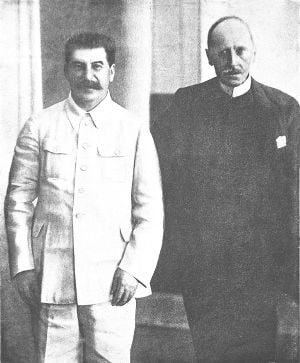
The state prosecutor, Andrey Vyshinsky, characterized Bukharin as an "accursed crossbreed of fox and pig" who supposedly committed a "whole nightmare of vile crimes".
While in prison, he wrote at least four book-length manuscripts including a lyrical autobiographical novel, How It All Began, a philosophical treatise, Philosophical Arabesques, a collection of poems, and Socialism and Its Culture – all of which were found in Stalin's archive and published in the 1990s.
Execution
Among other intercessors, the French author and Nobel laureate Romain Rolland wrote to Stalin seeking clemency, arguing that "an intellect like that of Bukharin is a treasure for his country." He compared Bukharin's situation to that of the great chemist Antoine Lavoisier who was guillotined during the French Revolution: "We in France, the most ardent revolutionaries ... still profoundly grieve and regret what we did. ... I beg you to show clemency."[39] He had earlier written to Stalin in 1937, "For the sake of Gorky I am asking you for mercy, even if he may be guilty of something," to which Stalin noted: "We must not respond." Bukharin was executed on March 15, 1938 at the Kommunarka shooting ground, but the announcement of his death was overshadowed by the Nazi Anschluss of Austria.[40]
According to Zhores and Roy Medvedev in The Unknown Stalin (2006), Bukharin's last message to Stalin stated "Koba, why do you need me to die?", which was written in a note to Stalin just before his execution. "Koba" was Stalin's nom de guerre, and Bukharin's use of it was a sign of how close the two had once been. The note was allegedly found still in Stalin's desk after his death in 1953.[41]
Despite the promise to spare his family, Bukharin's wife, Anna Larina, was sent to a labor camp, but survived to see her husband officially rehabilitated by the Soviet state under Mikhail Gorbachev in 1988.[42][43] Their son, Yuri Larin (born 1936), was sent to an orphanage in an attempt to keep him safe from the authorities, and also lived to see his rehabilitation.[44] His first wife, Nadezhda, died in a labor camp after being arrested in 1938. His second wife, Esfir' Gurvich, and their daughter Svetlana Gurvich-Bukharina (born 1924), were arrested in 1949, but survived past 1988, though they had lived in fear of the government their whole lives.[45]
Legacy
Bukharin was immensely popular within the party throughout the twenties and thirties, even after his fall from power. In his testament, Lenin portrayed him as the Golden Boy of the party,[46] writing:
Speaking of the young C.C. members, I wish to say a few words about Bukharin and Pyatakov. They are, in my opinion, the most outstanding figures (among the youngest ones), and the following must be borne in mind about them: Bukharin is not only a most valuable and major theorist of the Party; he is also rightly considered the favourite of the whole Party, but his theoretical views can be classified as fully Marxist only with great reserve, for there is something scholastic about him (he has never made a study of the dialectics, and, I think, never fully understood it) ... Both of these remarks, of course, are made only for the present, on the assumption that both these outstanding and devoted Party workers fail to find an occasion to enhance their knowledge and amend their one-sidedness.
Bukharin made several notable contributions to Marxist–Leninist thought, most notably The Economics of the Transition Period (1920) and his prison writings. [47]. He was a founding member of the Soviet Academy of Arts and Sciences, and a keen botanist. His primary contributions to economics were his critique of marginal utility theory, his analysis of imperialism, and his writings on the transition to communism in the Soviet Union.[48]
His ideas, especially in economics and the question of market-socialism, later became highly influential in the Chinese socialist market economy and Deng Xiaoping's reforms.
British author Martin Amis argues that Bukharin was perhaps the only major Bolshevik to acknowledge "moral hesitation" by questioning, even in passing, the violence and sweeping reforms of the early Soviet Union. Amis writes that Bukharin said "during the Civil War he had seen "things that I would not want even my enemies to see."[49] Despite his hesitations, he remained a loyal party member, helping Stalin rid himself of potential opposition on the left, until he became the target himself. His trial was a major turning point for some Western Marxists, like Arthur Koestler, who wrote about it in his famous novel, Darkness at Noon.
Works
Books and articles
- 1915: Toward a Theory of the Imperialist State
- 1917: Imperialism and World Economy
- 1917: The Russian Revolution and Its Significance
- 1918: Anarchy and Scientific Communism
- 1918: Programme of the World Revolution
- 1919: Economic Theory of the Leisure Class (written 1914)
- 1919: Church and School in the Soviet Republic
- 1919: The Red Army and the Counter Revolution
- 1919: Soviets or Parliament
- 1920: The ABC of Communism (with Evgenii Preobrazhensky)
- 1920: On Parliamentarism
- 1920: The Secret of the League (Part I)
- 1920: The Secret of the League (Part II)
- 1920: The Organisation of the Army and the Structure of Society
- 1920: Common Work for the Common Pot
- 1921: The Era of Great Works
- 1921: The New Economic Policy of Soviet Russia
- 1921: Historical Materialism: A System of Sociology
- 1922: Economic Organization in Soviet Russia
- 1923: A Great Marxian Party
- 1923: The Twelfth Congress of the Russian Communist Party
- 1924: Imperialism and the Accumulation of Capital
- 1924: The Theory of Permanent Revolution
- 1926: Building Up Socialism
- 1926: The Tasks of the Russian Communist Party
- 1927: The World Revolution and the U.S.S.R.
- 1928: New Forms of the World Crisis
- 1929: Notes of an Economist
- 1930: Finance Capital in Papal Robes. A Challenge!
- 1931: Theory and Practice from the Standpoint of Dialectical Materialism
- 1933: Marx's Teaching and Its Historical Importance
- 1934: Poetry, Poetics and the Problems of Poetry in the U.S.S.R.
- 1937–1938: How It All Began, a largely autobiographical novel, written in prison and first published in English in 1998.[50]
Cartoons
Bukharin was a cartoonist who left many cartoons of contemporary Soviet politicians. His cartoons are sometimes used to illustrate the biographies of Soviet officials. Russian historian Yury Zhukov stated that Nikolai Bukharin's portraits of Joseph Stalin were the only ones drawn from the original, not from a photograph.[51]
Notes
- ↑ Stephen F. Cohen, Bukharin and the Bolshevik Revolution: A Political Biography, 1888–1938 (Oxford, UK: Oxford University Press, 1980, ISBN 978-0195026979), 6. Retrieved December 22, 2022.
- ↑ Yuri Slezkine, The House of Government (Princeton, NJ: Princeton University Press, 2017, ISBN 978-1400888177).
- ↑ Lenin wrote a preface to Bukharin's book, Imperialism and the World Economy Vladimir Lenin, Lenin Collected Works Volume 22 (Moscow, RU: Progress Publishers, 1964), 103–107.
- ↑ Cohen, 44.
- ↑ Isaac Deutscher, The Prophet Armed: Trotsky 1879–1921 (New York, NY: Vintage Books, 1965), 246.
- ↑ Cohen, 44-46, 49.
- ↑ Leonard Schapiro, The Communist Party of the Soviet Union (New York, NY: Vintage Books, 1971, ISBN 978-0394707457), 175, 647.
- ↑ Cohen, 43–44, 50-53.
- ↑ Adam Ulam, The Bolsheviks: The Intellectual and Political History of the Triumph of Communism in Russia (Cambridge, MA: Harvard University Press, 1998, ISBN 0674078306), 410–412. Retrieved December 22, 2022.
- ↑ Alexander Rabinowitch, The Bolsheviks in power: the first year of Soviet rule in Petrograd (Bloomington, IN: Indiana University Press, 2007, ISBN 978-0253349439), 167, 174–175, 194. At the crucial meeting of the CEC convened at 3:00 am, on February 24, 1918, a few hours before the German ultimatum was due to expire, Bukharin had the courage to break ranks and voted against accepting the treaty, while many other Left Communists either observed party discipline (V. Volodarsky and Stanislav Kosior, for instance) or were simply "no shows" (Dzerzhinsky, Kollontai, Uritsky, etc.), 178).
- ↑ Cohen.
- ↑ "RUSSIA: Humble Pie," Time, October 25, 1926. Retrieved December 18, 2022.
- ↑ Cohen, 216.
- ↑ Paul R. Gregory, Politics, Murder, and Love in Stalin's Kremlin: The Story of Nikolai Bukharin and Anna Larina (Standford, CA: Hoover Institution Press, 2010, ISBN 978-0817910341), Chapters 3–6.
- ↑ Jules Humbert-Droz, De Lénine à Staline: Dix ans au service de l'Internationale communiste, 1921–1931 (Neuchâtel, CH: (Éditions de) la Baconnière, 1971).
- ↑ Gregory, Chapter 17.
- ↑ Robert Service, Stalin: A Biography (Cambridge, MA: Belknap Press, 2005, ISBN 978-0674016972), 260.
- ↑ Boris Nicolaevsky, Power and the Soviet Elite (New York, NY: Frederick A. Praeger, 1965), 15–16.
- ↑ Grigory Tokaev, Comrade X (London, UK: Harvill Press, 1956), 43.
- ↑ Andy McSmith, Fear and the Muse Kept Watch, the Russian Masters – from Akhmatova and Pasternak to Shostakovich and Eisenstein – Under Stalin (New York, NY: New Press, 2015, ISBN 978-1595580566), 131.
- ↑ Nadezhda Mandelstam, Hope Against Hope, a Memoir, trans. Max Hayward (London, UK: Collins & Harvill, 1971), 113.
- ↑ Mandelstam, 22.
- ↑ Maxim Gorky, Karl Radek and Nikolai Bukharin, Soviet Writers' Congress 1934, the Debate on Socialist Realism and Modernism (London, UK: Lawrence & Wishart, 1977, ISBN 978-0853154013), 233.
- ↑ Roy Medvedev, Nikolai Bukharin, The Last Years (New York, NY: W. W. Norton, 1980, ISBN 039301357X), 85–86.
- ↑ Medvedev, 138.
- ↑ Robert Conquest, Stalin and the Kirov Murder (New York, NY: Oxford University Press, 1989, ISBN 0195055799), 122-138.
- ↑ Alexander Yakovlev, "O dekabr'skoi tragedii 1934", Pravda, January 28, 1991, 3. in J. Arch Getty, "The Politics of Repression Revisited," in Stalinist Terror: New Perspectives ed. J. Arch Getty and Roberta T. Manning, (New York, NY: Cambridge University Press, 1993, ISBN 978-0521446709), 46.
- ↑ Nicolaevsky, 18–19.
- ↑ Edward Radzinsky, Stalin (New York, NY: Random House, 1997, ISBN 0385479549), 358. Retrieved December 18, 2022.
- ↑ 30.0 30.1 Alec Nove, The Stalin Phenomenon (New York, NY: Weidenfeld & Nicolson, 1993, ISBN 978-0297821083), 150. Retrieved December 18, 2022.
- ↑ Bertram David Wolfe, Breaking with Communism: The Intellectual Odyssey of Bertam D. Wolfe (Stanford, CA: Hoover Institution Press, 1990, ISBN 978-0817988814), 10.
- ↑ Arthur Koestler, Darkness at Noon (New York, NY: Bantam Books, 1984, ISBN 978-0553265958), 258.
- ↑ Orlando Figes, Revolutionary Russia, 1891–1991 (New York, NY: Metropolitan Books, 2014, ISBN 978-0805091311), 273.
- ↑ Robert Conquest, The Great Terror: A Reassessment (New York, NY: Oxford University Press, 2007, ISBN978-0195316995), 364–65.
- ↑ Helen Rappaport, Joseph Stalin: A Biographical Companion (Santa Barbara, CA: ABC-CLIO, 1999, ISBN 978-1576070840), 31.
- ↑ Stephen J. Lee, Stalin and the Soviet Union: (Questions and Analysis in History) (Oxfordshire, UK: Routledge, 1999, ISBN 978-0415185738), 33.
- ↑ Report by Viscount Chilston (British ambassador) to Viscount Halifax, No.141, Moscow, 21 March 1938.
- ↑ Robert Tucker, Report of Court Proceedings in the Case of the Anti-Soviet "Block of Rights and Trotskyites", 667–68.
- ↑ Radzinsky, 384.
- ↑ "Репрессии Членов Академии Наук,". Retrieved December 18, 2022.
- ↑ Zhores A. Medvedev & Roy A. Medvedev, The Unknown Stalin, trans. Ellen Dahrendorf (London, UK: I.B. Tauris, 2006, ISBN 978-1850439806), 296.
- ↑ Philip Taubman, "50 Years After His Execution, Soviet Panel Clears Bukharin," The New York Times, February 6, 1988. Retrieved December 18, 2022.
- ↑ David Remnick, "The Victory of Bukharin's Widow," The Washington Post, December 6, 1988. Retrieved December 19, 2022.
- ↑ Leonard Schapiro, "The Move to Rehabilitate Bukharin," The World Today 35(4) (April 1979): 160–166. Retrieved December 19, 2022.
- ↑ Stephen F. Cohen, The Victims Return: Survivors of the Gulag After Stalin (London, UK: I. B. Tauris, 2012, ISBN 978-1780761374).
- ↑ Christopher Westley, A Bolshevik Love Story, Mises Institute, March 30, 2011. Retrieved December 19, 2022.
- ↑ Nikolai Bukharin, Philosophical Arabesques (New York, NY: Monthly Review Press, 2005, ISBN 978-1583671023).
- ↑ Philip Arestis A Biographical Dictionary of Dissenting Economists (Cheltenham, UK: Edward Elgar Publishing, 1992, ISBN 978-1852783310), 88.
- ↑ Martin Amis, Koba the Dread: Laughter and the Twenty Million (New York, NY: Miramax, 2001, ISBN 978-0786868766), 115.
- ↑ Nikolai Bukharin, How It All Began trans. George Shriver. (New York, NY: Columbia University Press, 1999, ISBN 9780231107310).
- ↑ Viktor Baranets, KP.RU // «Не надо вешать всех собак на Сталина» Komsomolskaya Pravda, December 21, 2006. Retrieved December 19, 2022.
ReferencesISBN links support NWE through referral fees
- Amis, Martin. Koba the Dread: Laughter and the Twenty Million. New York, NY: Miramax, 2001. ISBN 978-0786868766
- Arestis, Philip. A Biographical Dictionary of Dissenting Economists. Cheltenham, UK: Edward Elgar Publishing, 1992. ISBN 978-1852783310
- Bergmann, Theodor, and Moshe Lewin (eds.). Bukharin in retrospect. Routledge, 2017.
- Bukharin, Nikolai. Philosophical Arabesques. New York, NY: Monthly Review Press, 2005. ISBN 978-1583671023
- Cohen, Stephen F. Bukharin and the Bolshevik Revolution: A Political Biography, 1888–1938. Oxford, UK: Oxford University Press, 1980. ISBN 978-0195026979
- Cohen, Stephen F. The Victims Return: Survivors of the Gulag After Stalin. London, UK: I. B. Tauris, 2012. ISBN 978-1780761374
- Conquest, Robert. Stalin and the Kirov Murder. New York, NY: Oxford University Press, 1989. ISBN 0195055799
- Conquest, Robert. The Great Terror: A Reassessment. New York, NY: Oxford University Press, 2007. ISBN 978-0195316995
- Deutscher, Isaac. The Prophet Armed: Trotsky 1879–1921. New York, NY: Vintage Books, 1965.
- Figes, Orlando. Revolutionary Russia, 1891–1991. New York, NY: Metropolitan Books, 2014. ISBN 978-0805091311
- Getty, J. Arch, and Roberta T. Manning. Stalinist Terror: New Perspectives. New York, NY: Cambridge University Press, 1993. ISBN 978-0521446709
- Gorky, Maxim, Karl Radek, and Nikolai Bukharin. Soviet Writers' Congress 1934, the Debate on Socialist Realism and Modernism. London, UK: Lawrence & Wishart, 1977. ISBN 978-0853154013
- Gregory, Paul R. Politics, Murder, and Love in Stalin's Kremlin: The Story of Nikolai Bukharin and Anna Larina. Standford, CA: Hoover Institution Press, 2010. ISBN 978-0817910341
- Humbert-Droz, Jules. De Lénine à Staline: Dix ans au service de l'Internationale communiste, 1921–1931. Neuchâtel, CH: (Éditions de) la Baconnière, 1971.
- Koestler, Arthur. Darkness at Noon. New York, NY: Bantam Books, 1984. ISBN 978-0553265958
- Lee, Stephen J. Stalin and the Soviet Union: (Questions and Analysis in History). Oxfordshire, UK: Routledge, 1999. ISBN 978-0415185738
- Mandelstam, Nadezhda. Hope Against Hope, a Memoir, translated by Max Hayward. London, UK: Collins & Harvill, 1971.
- McSmith, Andy. Fear and the Muse Kept Watch, the Russian Masters – from Akhmatova and Pasternak to Shostakovich and Eisenstein – Under Stalin. New York, NY: New Press, 2015. ISBN 978-1595580566
- Medvedev, Roy. Nikolai Bukharin, The Last Years. New York, NY: W. W. Norton, 1980. ISBN 039301357X
- Medvedev, Zhores A., and Roy A. Medvedev. The Unknown Stalin. translated by Ellen Dahrendorf, UK: London, I.B. Tauris, 2006. ISBN 978-1850439806
- Nicolaevsky, Boris. Power and the Soviet Elite. New York, NY: Frederick A. Praeger, 1965.
- Nove, Alec, The Stalin Phenomenon. New York, NY: Weidenfeld & Nicolson, 1993. ISBN 978-0297821083
- Rabinowitch, Alexander. The Bolsheviks in power: the first year of Soviet rule in Petrograd. Bloomington, IN: Indiana University Press, 2007. ISBN 978-0253349439
- Radzinsky, Edward. Stalin. New York, NY: Random House, 1997. ISBN 0385479549
- Rappaport, Helen. Joseph Stalin: A Biographical Companion. Santa Barbara, CA: ABC-CLIO, 1999. ISBN 978-1576070840
- Remnick, David. "The Victory of Bukharin's Widow,". The Washington Post, December 6, 1988. Retrieved December 19, 2022.
- Service, Robert. Stalin: A Biography. Cambridge, MA: Belknap Press, 2005. ISBN 978-0674016972
- Schapiro, Leonard. The Communist Party of the Soviet Union. New York, NY: Vintage Books, 1971. ISBN 978-0394707457
- Schapiro, Leonard. "The Move to Rehabilitate Bukharin," The World Today 35(4) (April 1979): 160–166. Retrieved December 19, 2022.
- Slezkine, Yuri. The House of Government. Princeton, NJ: Princeton University Press, 2017. ISBN 978-1400888177
- Tokaev, Grigory. Comrade X. London, UK: Harvill Press, 1956.
- Ulam, Adam, The Bolsheviks: The Intellectual and Political History of the Triumph of Communism in Russia. Cambridge, MA: Harvard University Press, 1998. ISBN 0674078306
- Westley, Christopher, A Bolshevik Love Story, Mises Institute, March 30, 2011. Retrieved December 19, 2022.
- Wolfe, Bertram David. Breaking with Communism: The Intellectual Odyssey of Bertam D. Wolfe. Stanford, CA: Hoover Institution Press, 1990. ISBN 978-0817988814
- Yakovlev, Alexander. "O dekabr'skoi tragedii 1934", Pravda, January 28, 1991, 3. in J. Arch Getty, "The Politics of Repression Revisited", in Stalinist Terror: New Perspectives edited by J. Arch Getty and Roberta T. Manning. New York, NY: Cambridge University Press, 1993. ISBN 978-0521446709.
Further reading
- Biggart, John. "Bukharin and the origins of the 'proletarian culture' debate". Soviet Studies 39(2) (1987): 229–246. Retrieved December 22, 2022.
- Biggart, John. "Bukharin's Theory of Cultural Revolution" in: Anthony Kemp-Welch (ed.), The Ideas of Nikolai Bukharin. Oxford:UK: Clarendon Press, 1992, ISBN 978-0198278665, 131—158.
- Coates, Ken. Who Was This Bukharin?. Nottingham, UK: Spokesman, 2010. ISBN 978-0851247816
- Fitzpatrick, Sheila. "The ABC of Communism Revisited". Studies in East European Thought 70(2–3) (2018): 167–179.
- Kotkin, Stephen. Stalin: Paradoxes of Power, 1878–1928. New York, NY: Penguin Press, 2014. ISBN 978-1594203794.
Primary sources
- Bukharin, Nikolaĭ, and Evgeniĭ Alekseevich Preobrazhenskiĭ. ABC of Communism. Socialist Labour Press, 1921.
- Bukharin, Nikolaĭ Ivanovich, et. al. Selected Writings on the State and the Transition to Socialism. Oxfordshire, UK: Routledge, 1982. ISBN 978-0873321907
External links
All links retrieved December 22, 2022.
- Nikolai Bukharin archive at marxists.org
- Bukharin's death-cell letter to Stalin
- How it all began, Bukharin's last letter to his wife
- A site dedicated to Bukharin
- A Bolshevik Love Story, Mises Institute
- February–March Plenum discussions transcript (in Russian) on which Bukharin was finally defeated, humiliated and expelled from Party
Credits
New World Encyclopedia writers and editors rewrote and completed the Wikipedia article in accordance with New World Encyclopedia standards. This article abides by terms of the Creative Commons CC-by-sa 3.0 License (CC-by-sa), which may be used and disseminated with proper attribution. Credit is due under the terms of this license that can reference both the New World Encyclopedia contributors and the selfless volunteer contributors of the Wikimedia Foundation. To cite this article click here for a list of acceptable citing formats.The history of earlier contributions by wikipedians is accessible to researchers here:
The history of this article since it was imported to New World Encyclopedia:
Note: Some restrictions may apply to use of individual images which are separately licensed.
